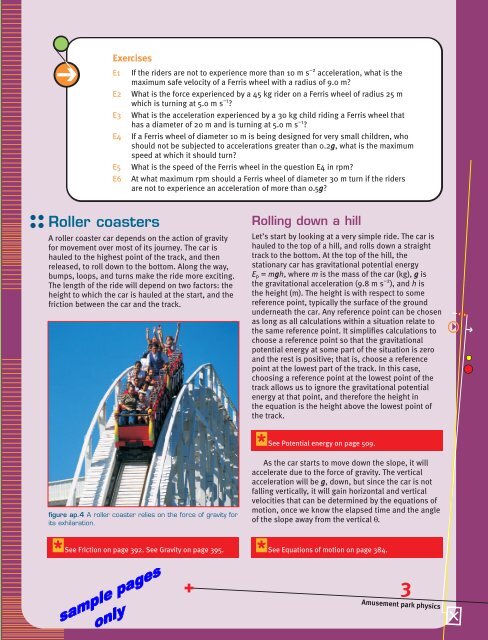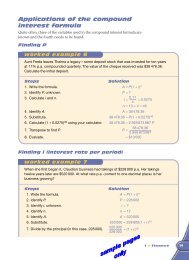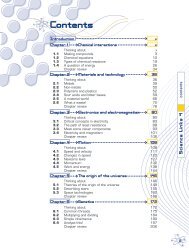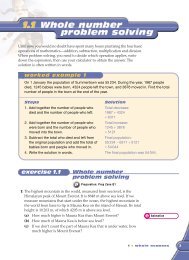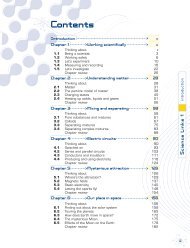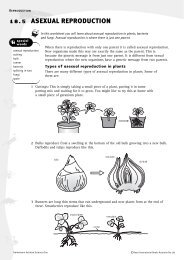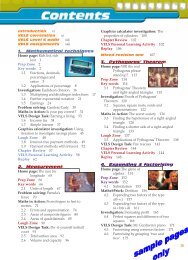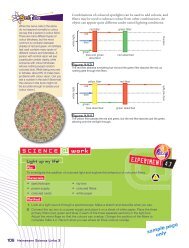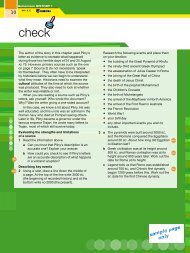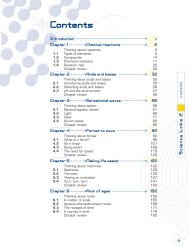Context 1: Amusement Park Physics - hi.com.au
Context 1: Amusement Park Physics - hi.com.au
Context 1: Amusement Park Physics - hi.com.au
Create successful ePaper yourself
Turn your PDF publications into a flip-book with our unique Google optimized e-Paper software.
➔<br />
Exercises<br />
Roller coasters<br />
E1 If the riders are not to experience more than 10 m s –2 acceleration, what is the<br />
maximum safe velocity of a Ferris wheel with a radius of 9.0 m?<br />
E2 What is the force experienced by a 45 kg rider on a Ferris wheel of radius 25 m<br />
w<strong>hi</strong>ch is turning at 5.0 m s –1 ?<br />
E3 What is the acceleration experienced by a 30 kg c<strong>hi</strong>ld riding a Ferris wheel that<br />
has a diameter of 20 m and is turning at 5.0 m s –1 ?<br />
E4 If a Ferris wheel of diameter 10 m is being designed for very small c<strong>hi</strong>ldren, who<br />
should not be subjected to accelerations greater than 0.2g, what is the maximum<br />
speed at w<strong>hi</strong>ch it should turn?<br />
E5 What is the speed of the Ferris wheel in the question E4 in rpm?<br />
E6 At what maximum rpm should a Ferris wheel of diameter 30 m turn if the riders<br />
are not to experience an acceleration of more than 0.5g?<br />
A roller coaster car depends on the action of gravity<br />
for movement over most of its journey. The car is<br />
h<strong>au</strong>led to the <strong>hi</strong>ghest point of the track, and then<br />
released, to roll down to the bottom. Along the way,<br />
bumps, loops, and turns make the ride more exciting.<br />
The length of the ride will depend on two factors: the<br />
height to w<strong>hi</strong>ch the car is h<strong>au</strong>led at the start, and the<br />
friction between the car and the track.<br />
figure ap.4 A roller coaster relies on the force of gravity for<br />
its ex<strong>hi</strong>laration.<br />
* See Friction on page 392. See Gravity on page 395.<br />
✚<br />
Rolling down a <strong>hi</strong>ll<br />
Let’s start by looking at a very simple ride. The car is<br />
h<strong>au</strong>led to the top of a <strong>hi</strong>ll, and rolls down a straight<br />
track to the bottom. At the top of the <strong>hi</strong>ll, the<br />
stationary car has gravitational potential energy<br />
Ep = mgh, where m is the mass of the car (kg), g is<br />
the gravitational acceleration (9.8 m s –2 ), and h is<br />
the height (m). The height is with respect to some<br />
reference point, typically the surface of the ground<br />
underneath the car. Any reference point can be chosen<br />
as long as all calculations wit<strong>hi</strong>n a situation relate to<br />
the same reference point. It simplifies calculations to<br />
choose a reference point so that the gravitational<br />
potential energy at some part of the situation is zero<br />
and the rest is positive; that is, choose a reference<br />
point at the lowest part of the track. In t<strong>hi</strong>s case,<br />
choosing a reference point at the lowest point of the<br />
track allows us to ignore the gravitational potential<br />
energy at that point, and therefore the height in<br />
the equation is the height above the lowest point of<br />
the track.<br />
* See Potential energy on page 509.<br />
As the car starts to move down the slope, it will<br />
accelerate due to the force of gravity. The vertical<br />
acceleration will be g, down, but since the car is not<br />
falling vertically, it will gain horizontal and vertical<br />
velocities that can be determined by the equations of<br />
motion, once we know the elapsed time and the angle<br />
of the slope away from the vertical θ.<br />
* See Equations of motion on page 384.<br />
3<br />
<strong>Amusement</strong> park physics<br />
<br />
<br />
⌧<br />
➔


